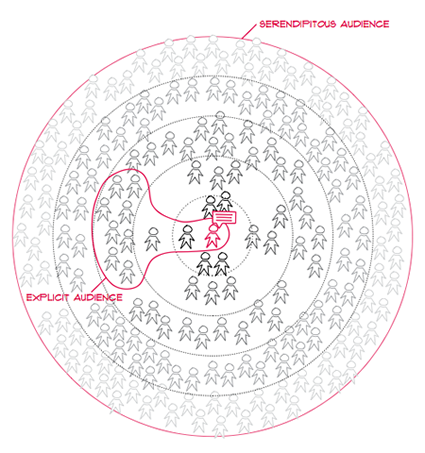
Paul Adams‘ book Grouped contains a lot of clear, rational sentences about human social behavior. They aren’t surprising sentences, but I don’t think anyone’s put all these insights in one place before in plain language. The insights are the result of years of research by many different people. The book cuts through the noise of the commentary on all things social on the social web, pro and con, with simple facts. It makes a debate about the relevance of social influence on shopping behavior, for example, feel like a debate among fish about the existence of water.
Humans are social animals. Through the scientific method, we’ve managed to observe a few things about ourselves. We’ve learned that how we behave is learned from observing others. We are more influenced by the behavior of people in our group, and people we perceive to be like us. We may communicate infrequently with our many weak ties, but they are often better sources of information than the people in our inner circle.
One core premise of the book is that the amount of information accessible to us has been increasing dramatically, but our brains’ capacity for processing ideas and memory has not, so it’s natural to look for clues and guidance from other people online, as we’ve been doing offline for millenia. The web has been catching up with how people naturally operate, as it gets “rebuilt around people.” Most of our decision-making happens in the nonconscious, emotional part of our brain, and it’s influenced by the behavior we observe among people in our group.
Facebook happens to make it easy to observe the behavior of people you’re connected to. It’s almost like the ticker on the right side of the screen on Facebook was designed for nonconscious observation of other people’s behavior. With open graph apps piping in the reading, listening and shopping behavior of people you’re connected to, you can start to see where this is going. It’s not that you’ll see your friends favoriting things and go and favorite or buy those things, but you’ll observe their behavior and get used to the idea of finding things to favorite yourself. Small requests for behavioral change are more effective than interrupting people with marketing messages. And behavioral change often leads to attitudinal change.
If you’re building something you want people to use, like a website, this stuff matters.
The only downside to the book, for me, is the acceptance of brands as they exist today as facts of life.
I recommend the ‘Further Reading’ section of each chapter in particular. Read it by your computer.